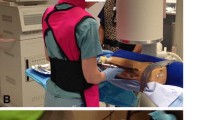Zusammenfassung
Als die Deutsche Gesellschaft für Anästhesiologie und Intensivmedizin (DGAI) im Jahre 2003 allen interessierten universitären anästhesiologischen Kliniken einen Full-scale-Simulator als Leihgabe für den studentischen Unterricht anbot, wurde dieser innovative Schritt mit großem Enthusiasmus begrüßt. Eine Jahre später durchgeführte Umfrage anlässlich eines Treffens der beteiligten Kliniken ergab jedoch ein sehr heterogenes Bild bezüglich der zur Verfügung stehenden Räumlichkeiten: Zwar war es einigen anästhesiologischen Kliniken gelungen, einen ganzen OP-Trakt als Trainingsräumlichkeiten zu akquirieren, jedoch war dies die Ausnahme. In den meisten Kliniken standen lediglich 1 (bis 2) Räume zur Verfügung und an manchen Standorten musste der Simulator sogar für jeden Unterricht erst aus einem Lagerraum geholt und »auf freiem Feld« aufgebaut werden.
Access this chapter
Tax calculation will be finalised at checkout
Purchases are for personal use only
Preview
Unable to display preview. Download preview PDF.
Similar content being viewed by others
Literatur
Brost B, Thiemann K, Belda T et al. (2008) Creation of structurefunction relationships in the design of a simulation center. In: Kyle R, Murray W (Hrsg) Clinical simulations. Operation, clinical engineering and management. Elsevier, Des Plaines, 185–199
Coker N (2008) Designing and developing a multi-institutional, multidisciplinary regional clinical simulation center. In: Kyle R, Murray W (Hrsg) Clinical simulation. Operations, engineering and management. Elsevier, Des Plaines, USA, 321–334
Goodrow M (2008) Health care simulation with patient simulators and standardized patients. In: Kyle R, Murray W (Hrsg) Clinical simulation. Operations, engineering and management. Elsevier, Des Plaines, 283–300
Horley R (2008) Simulation and skill centre design. In: Riley R (Hrsg) Manual of simulation in healthcare. Oxford University Press, New York, 3–11
Kyle R (2004) Technological resources for clinical simulation. In: Dunn W (ed) Simulation in Critical Care and beyond. Society of Critical Care Medicine, Des Plaines, p 95–113
Kyle R, Murray W (2008) Clinical Simulation. Operations, Engineering and Management. Elsevier, Des Plaines
Loyd G (2004) Issues in starting a simulation center. In: Dunn W (ed) Simulators in critical care and beyond. Society of Critical Care Medicine, Des Plaines, p 84–90
Miller J (2008) Thought thinking itself out: anticipatory design in simulation centers. In: Kyle R, Murray W (Hrsg) Clinical Simulation. Operations, Engineering and Management. Elsevier, Burlington 167–176
Seropian M (2008) Simulation facility design 101: The basics. In: Kyle R, Murray W (Hrsg) Clinical Simulation. Operations, Engineering and Management. Elsevier, Burlington, 177–184
Stern D (2008) Choosing full-function patient simulators, creating and using the simulation suite. In: Kyle R, Murray W (Hrsg) Clinical simulation. Operations, engineering and management. Elsevier, Des Plaines, 205–215
Ziv A, Erez D, Berkenstadt H (2008) Simulation on a national level: Israel. In: Kyle R, Murray W (Hrsg) Clinical Simulation. Operations, Engineering and Management. Elsevier, Des Plaines, USA, 371–375
Ziv A, Erez D, Munz Y et al. (2006) The Israel Center for Medical Simulation: A Paradigm for Cultural Change in Medical Education. Academic Medicine 81: 1091–1097
Ziv A, Rubin O, Moshinsky A et al. (2008) MOR: a simulationbased assessment center for evaluating the personal and interpersonal qualities of medical school candidates. Med Educ 42: 991–998
Weiterführende Links
ATS: www.aluminumtrailer.com (abgerufen am 07.09.2012)
WISER: http://www.wiser.pitt.edu/apps/courses/coursebytype. asp (abgerufen am 07.09.2012)
Author information
Authors and Affiliations
Editor information
Editors and Affiliations
Rights and permissions
Copyright information
© 2013 Springer-Verlag Berlin Heidelberg
About this chapter
Cite this chapter
St.Pierre, M., Breuer, G. (2013). Vom Zimmer zum Zentrum – form follows function. In: St.Pierre, M., Breuer, G. (eds) Simulation in der Medizin. Springer, Berlin, Heidelberg. https://doi.org/10.1007/978-3-642-29436-5_1
Download citation
DOI: https://doi.org/10.1007/978-3-642-29436-5_1
Publisher Name: Springer, Berlin, Heidelberg
Print ISBN: 978-3-642-29435-8
Online ISBN: 978-3-642-29436-5
eBook Packages: Medicine (German Language)




